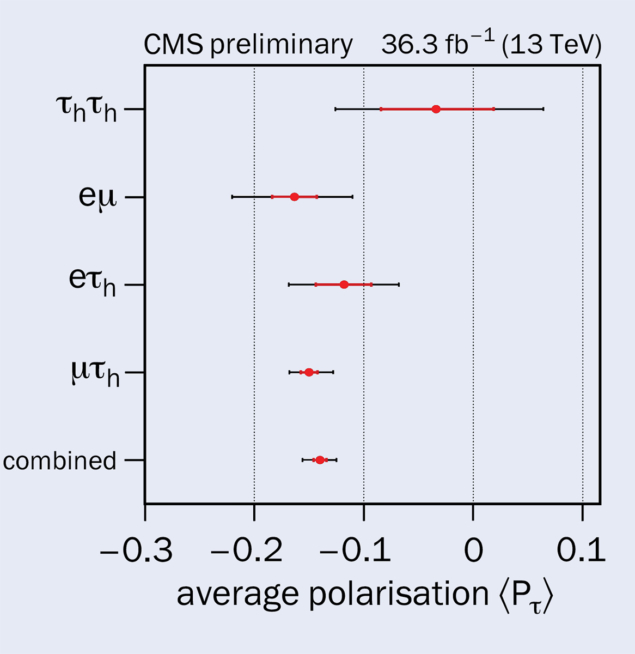A report from the CMS experiment.

Precision electroweak measurements are a powerful way to probe new physics, through the indirect effects predicted by quantum field theory. The electroweak mixing angle θWeff is particularly sensitive to new phenomena related to electroweak symmetry breaking and the Brout–Englert–Higgs mechanism. It was measured at LEP in different processes; and at the LHC, thanks to the large number of collected events with Z-boson decays, the experiments can probe these effects with comparable sensitivity.
The CMS collaboration has reported a new measurement of the tau-lepton polarisation in the decay of Z bosons to a pair of tau leptons in proton–proton collisions at 13 TeV. The polarisation is defined as the asymmetry between the cross sections for the production of τ– with positive and negative helicities, and is directly related to the electroweak mixing angle via the relation Pτ ≈ –2(1–4 sin2θWeff). The polarisation of the tau lepton is determined from the angular distributions of the visible tau decay products, leptonic or hadronic, with respect to the τ flight direction or relative to each other. A so-called optimal polarisation observable is constructed using all of these angular properties of the tau decay products. Since the spin states in Z0 → τ–τ+ are almost 100% anti-correlated, the sensitivity is improved by combining the spin observables of both τ leptons of the pair.

The average polarisation〈Pτ〉is obtained by a template fit to the observed optimal τ-polarisation observables, using tau-lepton pairs with an invariant mass in the range 75–120 GeV. As summarised in figure 1, the best sensitivity of Pτ is found in the channel where one tau decays to a muon and the other decays hadronically, thanks to the good selection efficiency and reconstruction of the spin observable in this channel. The fully hadronic final state suffers from higher trigger thresholds, which lead to fewer events and distortions of the templates.
The average τ polarisation is corrected to the value at the Z pole, Pτ (Z0) = –0.144 ± 0.006 (stat.) ± 0.014 (syst.), where the systematic uncertainty is dominated by the incorrect identification of the products of hadronically decaying tau leptons. The effective weak mixing angle is then determined as sin2θWeff = 0.2319 ± 0.0019, in agreement with the Standard Model (SM) prediction. Figure 2 compares the tau– lepton asymmetry parameter (the negative of the polarisation) with results from previous experiments, demonstrating that the CMS measurement is nearly as precise as those of single LEP experiments.
This measurement shows that LHC collision events, although much more complex than those collected at LEP, can provide precise determinations of the polarisation of the τ lepton, as well as of spin correlations between τ-lepton pairs. Such measurements are crucial to probe the CP properties of the Higgs boson’s Yukawa coupling to τ leptons, which is an important step in the path to understand the Higgs sector of the SM.
Further reading
CMS Collab. 2023 CMS-PAS-SMP-18-010.







